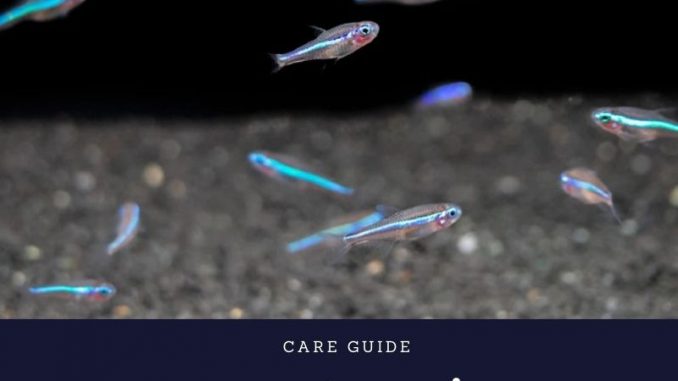
There are many popular tetra varieties for home aquariums, each desirable in its own way, but green neon tetras often go under the radar.
This seems strange, as they are an incredibly colorful and social species, adding plenty of interest to a fish tank. They are very similar, but in some ways more beautiful, than their cousin, the neon tetra.
They are easy to care for too. If you can maintain the right content, you will have some healthy individuals for a few years. Even beginners can manage this species.
This article contains all the information for need when adding green neon tetras to your aquarium. This includes their diet, preferred setup, how to breed them, and much more.
TABLE OF CONTENTS
Green Neon Tetra Facts & Overview
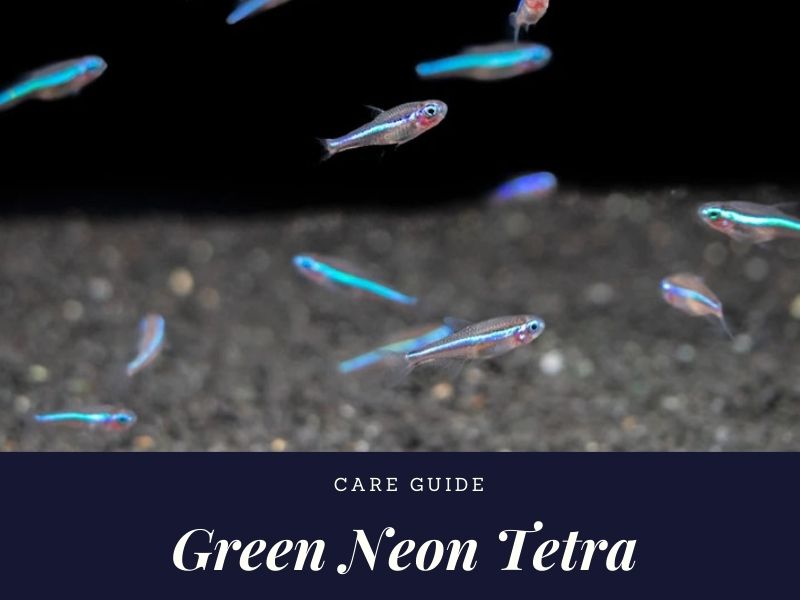
| Category | Rating |
| Care Level: | Easy |
| Temperament: | Peaceful |
| Color Form: | Green/blue and red |
| Lifespan: | Up to 2-3 years |
| Size: | Up to an inch |
| Diet: | Omnivore |
| Family: | Characidae |
| Minimum Tank Size: | 10 gallons |
| Tank Set-Up: | Freshwater: live plants and open swimming spaces |
| Compatibility: | Peaceful community |
The Green Neon Tetra is a vibrant freshwater fish. Though rare, you may sometimes see these fish labeled as Blue Neons or False Neons.
Their scientific name is Paracheirodon simulans and they are part of the Characidae family.
This family contains lots of popular aquarium species. This includes some exotic fish like Piranhas, but the most notable examples are primarily other varieties of tetra.
There are countless examples of tetras, Green Neon Tetras are most closely related to the famous Neon Tetra, as you might expect from the name.
Most aquarists are familiar with Neon Tetras, they are a common first fish for beginners. The green variety is also an excellent choice for beginners, its needs are simple, so it is easy to care for.
The main differences with Neon Tetras are that Green Neons are slightly smaller and vary in color.
Like all tetras, this species originates in the Americas. More specifically, it is native to the Orinoco and Negro Rivers that run through South America.
The popularity of tetras means that they are commonly sold in pet stores. It won’t take you long to find a stock near you.
Green Neon Tetras are easily commercially bred, which means they can be sold cheaply. They should only cost $2-$3 each, but you can usually get them cheaper when buying a group.
Check their health before you purchase some. Look out for physical wounds or signs of disease like changes in color or spots across their body. Shop elsewhere if you notice an issue.
In an aquarium, a healthy fish will live to 2-3 years old, but this could extend further in a pristine environment with a healthy diet. They can live up to 10 years in the wild.
Typical Behavior
These fish are peaceful and inoffensive. They show no signs of aggression and will live alongside other species in a community without causing problems.
You do need to consider tank mates carefully though, as this small species could easily be eaten by larger fish.
They are also easy to spook. Fast, boisterous fish will intimidate your Green Neon Tetras, stressing them out, which may lead to more severe health problems.
These fish feel more confident in a group. They are naturally social shoaling fish that will move around in unison.
Not only is the synchronicity impressive, but a shoal will exaggerate its colors to brighten up your aquarium. The larger the group, the better the display.
Keeping a Green Neon Tetra singly is almost cruel. They become stressed when lonely and won’t survive as long. You will need at least 6-8 of them in your tank.
They occupy the middle levels of the water column but will come up to the surface for food.
While they shoal through the day to feel safe around other fish, it is every man for himself at feeding time.
Appearance

If you have ever seen any species of tetra before, you will know that they are very colorful, especially when in a large group.
Green Neon Tetras are no different. They sparkle under bright lights, even when in an Amazonian “black water” environment. Once the lights go out, their colors reduce significantly.
Their name is a little deceptive since they are not much greener than Neon or Cardinal Tetras. This often leads to misidentification between the three species.
All three have a blueish-green stripe running laterally along their torpedo-shaped body, even extending through the eye. The difference in color is to do with the red underneath this stripe.
While the red is still there, it is much less obvious on Green Neon Tetras. While this might sound like a negative, it helps the blues/greens to stand out, making them appear brighter.
This is why they are called Green Neon Tetras because the green colorations are able to shine.
Though their body is bright, their fins are small and colorless, you can see right through them.
A fully grown Green Neon Tetra can reach up to an inch long, which is slightly smaller than closely related species. There is often a genetic component to size though, so it might vary between populations.
Sexing this species is tough. Females tend to be a bit larger with a rounder body, but the difference is very slight.
Habitat and Tank Conditions
A Green Neon Tetra’s natural habitat is in the freshwater Orinoco and Negro Rivers, which span a few countries across South America.
They are mostly found in tributaries that are shallower and contain lots of dense vegetation and debris on top of a sandy substrate.
These areas are usually blackwater environments. The water is tinted by tannins released from trees, which causes a reduction in water clarity and pH.
The rivers are in a subtropical climate, so the acidic waters are warm. There wouldn’t be much light though, sunlight is blocked by foliage and the darkened water.
Water currents are not particularly strong here.
Occasionally populations will stray to other areas, but they will stay in regions with similar environmental conditions.
When designing an aquarium, your aim should always be to replicate the natural environment of the fish you want. This is easy to do for Green Neon Tetras, we’ll outline how below.
Tank Conditions
Layer the bottom of the tank in a sandy substrate to best recreate a South American river.
Green Neon Tetras do not spend much time at the bottom of the tank, so you can instead consider the needs of any bottom-dwelling fish you might want if you’re starting a community.
You can add decorations on top of the substrate. These fish are used to being around debris and often use it to hide.
Live plants are even more important though, they offer natural shelter and help to keep the water clean. Include areas of dense vegetation that reach up into the water column.
Hornwort is a tall, hardy plant species that anyone can care for.
You will also need large open swimming spaces where shoals are free to display their active and social lifestyle.
If you want to create a true blackwater environment, you could add driftwood. This will release tannins which will darken the water and lower pH.
This isn’t essential. You don’t have to darken the water, but you will need to maintain a pH between 5.0 and 6.5.
Set your heater within the range of 75°F-85°F. You will need very soft water.
The current produced by your filter outlet will be enough. This species isn’t from areas with fast-flowing water.
Do not use bright lights either. Standard aquarium lighting will be fine, but Green Neon Tetras prefer dimmer lighting if possible.
What Size Aquarium do they need?
These fish are small so they will fit into small tanks. A group of 6 could be kept in a 10-gallon aquarium, provided that there were few decorations to leave plenty of swimming space.
Keeping a larger shoal or starting a community will need a larger tank.
The more space you can provide for your fish the better. They will be less stressed and more likely to display natural behaviors in larger tanks.
It is easier to maintain water conditions in larger tanks too, which is important for Green Neon Tetras.
How Many Can be kept per gallon?
Adding more fish will require more space. Try to provide 2-3 gallons for every extra fish you keep in your shoal. Supplying more than this will be appreciated though.
Tank Mates

Green Neon Tetra are very peaceful fish that won’t show any signs of aggression.
This makes it very easy to find suitable tank mates. There are countless examples, such as danios, other tetras, dwarf gourami, Corydoras catfish, and cherry barbs.
The key is to pick other peaceful species of a similar size.
Boisterous fish or aggressive will stress out your Green Neon Tetras. They won’t be able to fight back and will end up injured.
A large enough fish will be able to eat these tetras because they are such a small variety, so bear this in mind.
You could try adding some invertebrates. Shrimps and snails are an interesting way to diversify the activity in your tank; they will largely be ignored by these fish too.
Though Green Neon Tetra is suitable for a community aquarium, they are great for a single species tank too. This gives them the freedom to show off their colors and swimming patterns.
Can You Keep Green Neon Tetras Together?
Never keep Green Neon Tetras alone. They should always be in a group of their own kind.
These fish naturally shoal, grouping up and moving around the tank in unison. This strength in numbers makes them feel more confident around other inhabitants of the tank.
A lone Green Neon Tetra will become stressed, which may lead to health problems and will likely reduce their lifespan.
Aim to have a group of at least 6, but they will be happier in larger groups if you have space in your aquarium.
It is worth keeping a large group because it emphasizes their colors and behaviors.
Diet
There are lots of options available to you when designing a diet. Green Neon Tetras would naturally eat a range of foods in the wild, so there’s a wide variety of foods they can eat in captivity too.
As omnivores, they will happily consume both meaty foods and vegetation.
Virtually every pet store will sell dried foods like flakes and pellets. These are very convenient because they’re cheap and easy to store.
The problem with dried foods is that they lose most of their nutritional value during the manufacturing process.
Never feed your Green Neon Tetras a diet based solely on dried foods. You will need to supplement them with live/frozen foods which are full of nutrients.
Live foods will help to encourage hunting/foraging behaviors.
Some good examples are bloodworms, mosquito larvae, daphnia, and brine shrimp. These would be similar to what they would eat in the wild – small insects and crustaceans.
They would also eat organic matter, so you could cut up small pieces of green vegetables (Lettuce, zucchini, spinach, etc.) for them. This is a good way to use up excess food from your kitchen.
A varied diet is needed to maintain healthy fish, so try to switch things up now and then.
Feed your Green Neon Tetras 2-3 times a day, each time only giving them an amount they can easily finish within 2 minutes.
Care
Beginners will enjoy caring for Green Neon Tetras. Their needs aren’t tough to meet, but maintaining their preferred conditions is important.
This species can be sensitive to changes in their environment, so pay attention to the condition of your aquarium.
Buy a water testing kit. You should use this each week to make sure that the parameters of the water are at the correct levels. Regular checks will mean you can respond to problems before they become catastrophic.
Maintaining a clean tank will help to maintain the water conditions. This involves performing regular partial water changes and clearing away any algal outbreaks.
Cleaning your tank will help to prevent outbreaks of disease too. Pathogens thrive in a poor-quality environment.
Pathogens are usually introduced when adding second-hand equipment or new fish.
Use a quarantine tank before adding new fish to your main aquarium. You can also use this tank to treat your fish; separate infected fish into a quarantine tank before the disease can spread to others.
Luckily, Neon Green Tetra isn’t prone to any species-specific diseases, but they can be afflicted by common freshwater diseases like ich.
This is an ectoparasite that causes white spots to appear across a fish’s body.
Stressed fish are more vulnerable to disease, so make sure you have designed a suitable aquarium for all inhabitants.
You can buy treatments for the most common pathogens in pet stores.
Breeding
Breeding your Green Neon Tetras is possible, but not necessarily easy. You will need the perfect environment in order to get your fish ready to mate.
Create a dedicated species tank for Green Neon Tetras. Keep this aquarium as clean as possible; maintaining their preferred water conditions is crucial.
A healthy diet is also important. Their food should be varied and full of nutrients.
There are a couple of ways to trigger spawning. One is to gradually lower the pH to 5.0 and the other is to gradually raise the temperature to 85°F. You could try both.
Reducing the amount of intensity of your light is advisable too.
Once your aquarium is set up with the required parameters, all you can do is keep an eye on your fish and wait.
Males and females will start to pair up and stay very close to each other while mating.
The female will spread about 100 fertilized eggs around the tank, usually near plants. The male will follow her to make sure all the eggs are fertilized.
Remove the adults once the eggs are laid so that they aren’t eaten.
Once the eggs hatch, feed them baby brine shrimp and infusoria until they are large enough to eat an adult diet.
Are Green Neon Tetras Suitable for Your Aquarium?
If you have a peaceful community of tropical fish, chances are that Green Neon Tetras will make an excellent addition.
As long as the water conditions are suitable, this species can go into most aquariums. Tankmates will need to be peaceful and of a similar size, to ensure your tetras aren’t eaten or stressed out.
Caring for these fish is simple, making them suitable for beginners. As omnivores, their dietary needs are easy to provide for, there is a wide range of possible foods to give them.
Aquarists looking to breed them may struggle, but it is possible so don’t give up, you just need to be patient. Design the perfect tank and it should happen eventually.
Green Neon Tetras are a wonderful way to brighten up an aquarium. Their colors and shoaling behaviors will keep you captivated for hours on end.
Are Green Neon Tetras your favorite tetra species? Let us know in the comments below…

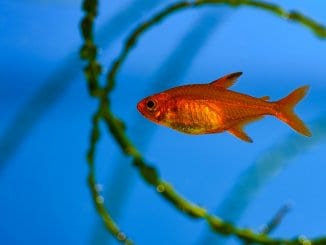
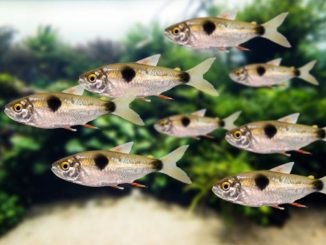
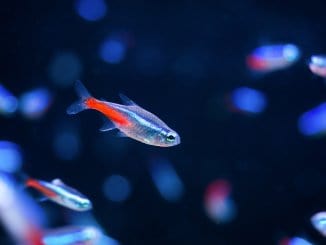
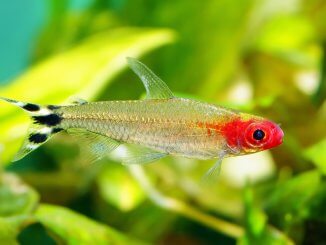
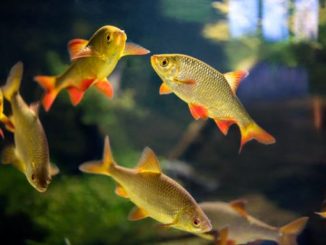
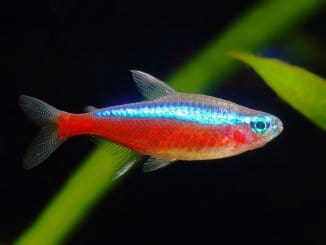
Be the first to comment